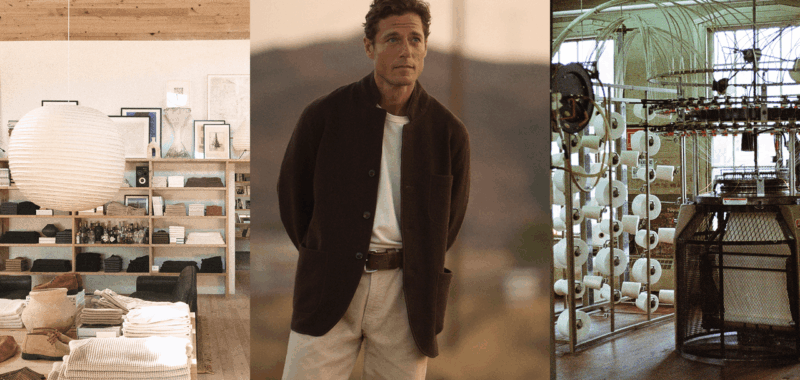Rather than simply recreating the look of these garments, Ford and Koehn’s approach to design involves a painstaking process of reverse engineering, from studying the way vintage fabrics were woven to replicating the bygone production techniques that helped them stand the test of time. “When you spend years poring over vintage references, you get hooked on the little things,” Ford says, explaining how the brand’s Welterweight sweats incorporate old-school construction techniques like seams reinforced with flatlock stitching and flexible ribbed gussets at high-stress points. “When function precedes form, it’s hard to go wrong”.
When Ford and Koehn set out to create Buck Mason’s first pair of jeans, they started by pulling vintage pieces from their extensive personal collections, deconstructing them to analyze everything from the size and shape of the J-stitch over the fly and the type of stitches that secure the waistband, to the different styles of overlock stitching used on edges and hems. “Every detail affects how a pair of jeans ages over time, from the way they wash to how the whiskers develop within,” Koehn explains. “We wanted to create jeans that didn’t just look like our favorite vintage references, but actually wore like them, too.”
Combining the attention to detail usually found in niche, higher-end labels with the accessibility of a mall brand has helped Buck Mason gain a loyal following, from guys who live in jeans and tees to card-carrying members of the menswear Illuminati.
Part of the appeal is a strong and consistent aesthetic vision, explains Jake Woolf, a longtime GQ contributor who now writes on Substack. “I think Buck Mason’s popularity stems from the fact that they’ve cultivated a strong POV about their version of a high-quality, classic menswear wardrobe, but they’ve also maintained a vibe that’s completely un-fussy,” he says. “It’s like, yeah, they do really great workwear, but nothing in the range is overly distressed or feels expensive just for the sake of it.”
The other side of this coin, and one that appeals as much to die-hard menswear nerds as guys who are just starting to build out their closets, is the fact that pretty much everything goes with everything else. “I appreciate that Buck Mason’s design ethos isn’t overly trend-driven, which means their pieces can be worn season after season without feeling dated,” says Turner Allen, an NYC-based personal stylist. “Their color palette leans heavily into neutrals, which makes layering and mixing incredibly straightforward. It takes a lot of the guesswork out of building a cohesive wardrobe.”
Buck Mason’s ability to nail the cross-section of style, quality, and affordability has been instrumental to its success, but it’s also managed to maintain the balance while growing exponentially over the past decade. Plenty of fashion brands with strong concepts and the best of intentions eventually run into a hard wall of uneven balance sheets and impatient investors. The sacrifices to quality and vision that ensue have defeated many a designer—and helped to create a retail landscape dominated by fast fashion and luxury, with little in between.

